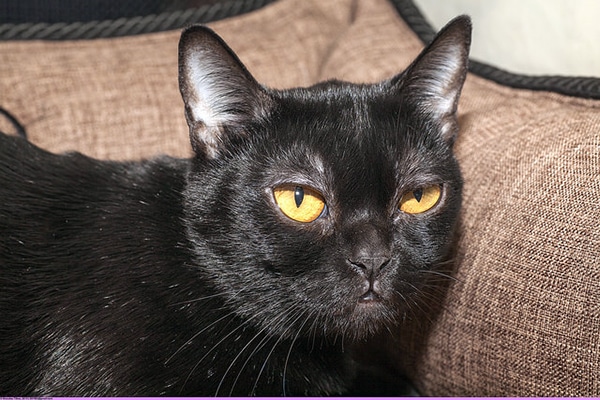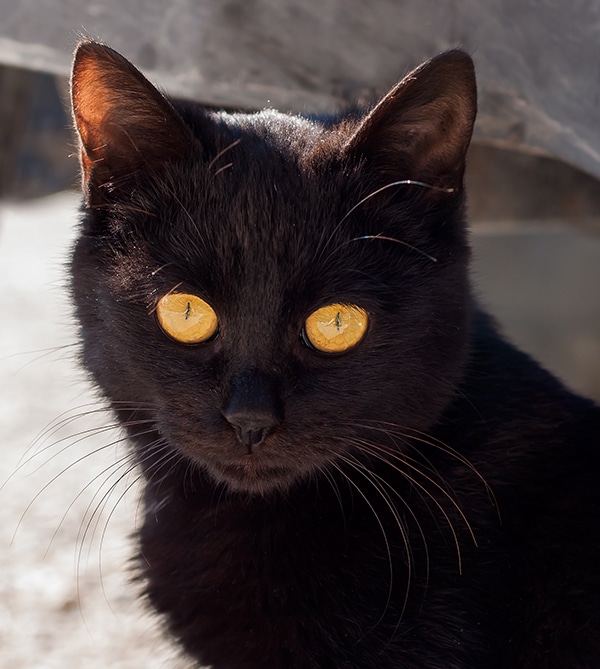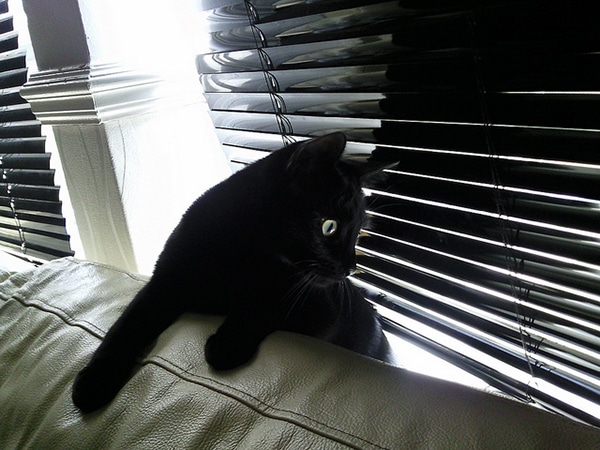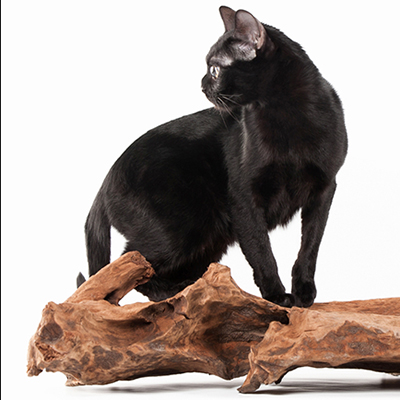I’ve always loved black cats, and I’ve drooled over Bombays for years. Who wouldn’t love that beautiful, gleaming black coat and the round, curious copper-colored eyes?
Origins
Louisville, Kentucky, cat breeder Nikki Horner apparently loved black cats as much as I do, because she was inspired to create a cat that she referred to as a “parlor panther.” In 1953, she cross-bred a grand champion sable Burmese and a black American Shorthair with rich eye color. After many years of diligent effort, she was able to consistently produce cats with deep black fur and copper-colored eyes. In 1976, the Bombay achieved championship status in the Cat Fanciers’ Association, and the International Cat Association accepted it for championship status in 1979. The Bombay is still a pretty rare breed, but its following is dedicated and passionate.

Appearance
The Bombay is sometimes called “the patent leather kid with the new penny eyes” because of his shiny black fur and striking gold or orange eyes. Although the Bombay’s body shape is moderate — not too cobby and not too lean — the face is very round, with wide-set round eyes and a short muzzle. The Bombay’s fur is black from the roots to the tips and its shiny texture accentuates a muscular body. Bombays typically weigh between six and 10 pounds, with males being heavier.

Health and longevity
The Bombay was created from two breeds known for good health. However, they still have a slightly higher than usual risk for developing hypertrophic cardiomyopathy. Their short noses can lead to excessive watering of the eyes and breathing difficulties. The breed is especially prone to obesity, so be sure to stay on top of your Bombay’s weight and feed appropriate amounts of a high-quality food.

What it’s like to live with a Bombay
Bombays are an exceptionally easygoing and sociable cat. She’ll greet you with tail-in-the-air joy at the end of your work day and she’ll be the first to welcome new visitors to your home. Her high intelligence makes it easy to train her to walk on a leash or play fetch; it also gives her enough smarts to create endless ways to entertain herself, and you. Once she’s done playing, though, your Bombay will be happy to curl up in your lap or snuggle under the blankets with you.
Your Bombay won’t be happy if she’s left alone for long periods of time, so if you’re out of the house a lot, consider getting her a kitty friend or having a cat sitter stop in and spend time with her.
When it comes to grooming, the Bombay is a low-maintenance cat. She doesn’t shed much, so weekly brushing with a rubber curry brush will take care of the hair and give her a nice massage at the same time.

Bombay trivia bits
- The Bombay got her name because breed founder Nikki Horner’s inspiration for the cat’s look was the black leopard of India.
- Although American Bombays almost always have copper-colored eyes, British Burmese more often have gold or green eyes.
- Bombays, like most Oriental breed cats, reach sexual maturity early — sometimes as early as five months — but they may not reach their full physical growth until they’re about two years old.
Do you have a Bombay in your home? What’s it like to live with him or her? Please share your thoughts and photos of your Bombay in the comments.
Read more about cat breeds on Catster:
- Get to Know the Persian: The Original Feline Nobility
- 5 Purebred Cat Breeds I’d Have a Hard Time Saying No To
- Get to Know the Egyptian Mau: A Sensitive Cat With a Wild Look
- Get to Know the Siberian: The Folk Cat of the Great Frozen North
- Get to Know the Manx: A Mighty Hunter and Sweet Companion
- Get to Know the American Shorthair: One of America’s Original Cats








